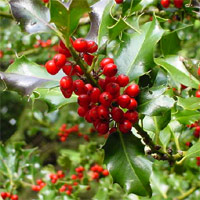Holly

Hollies include a large number of deciduous and evergreen shrubs and trees that are grown for their attractive foliage and brightly colored berries. Other common names include inkberry, winterberry, and yaupon.
About This Plant
Most hollies have glossy, prickly foliage. The plants are dioecious , meaning there are both male and female plants. For female plants to produce their brightly colored berries, a compatible male plant must be planted nearby. There are evergreen and deciduous hollies; evergreen types tend to be less hardy than deciduous ones. Size ranges from 6 to 40 feet tall and wide, depending on the type. Evergreen hollies can be sheared into formal hedges, and holly berries attract birds.
Special Features
Evergreen
4-Season interest
Site Selection
In general, hollies prefer a site with full sun to light shade and moist, well-drained soil. Some species, such as inkberry (
Ilex glabra), are adapted to wet areas. Most hollies prefer slightly acidic soil; however, some species, such as winterberry (
I. verticillata), require more acidic soils.
Planting Instructions
Plant in spring or fall. Space plants 5 to 25 feet apart, depending on the expected mature size of the plants. Dig a hole only as deep as the root ball and 2 to 3 times as wide. If your soil is in very poor condition, amend the soil you've removed from the hole with a small amount of compost. Otherwise don't amend it at all. Carefully remove the plant from the container and set it in the hole. Fill the hole half full with soil, then water it well to settle the soil and eliminate air pockets. Let the water drain, then fill the remainder of hole with soil and water thoroughly.
Care
Apply a layer of compost under the tree each spring, spreading it out to the dripline (the area under the outermost branches). Add a 2-inch layer of mulch to retain moisture and control weeds, keeping mulch a few inches away from the tree trunk. Water plants during the summer if rainfall is less than 1 inch per week. Hollies require little pruning. They will, however, tolerate the severe pruning required for formal hedges and topiaries. Prune in spring to optimize berry production.






 Hollies include a large number of deciduous and evergreen shrubs and trees that are grown for their attractive foliage and brightly colored berries. Other common names include inkberry, winterberry, and yaupon.
Hollies include a large number of deciduous and evergreen shrubs and trees that are grown for their attractive foliage and brightly colored berries. Other common names include inkberry, winterberry, and yaupon.